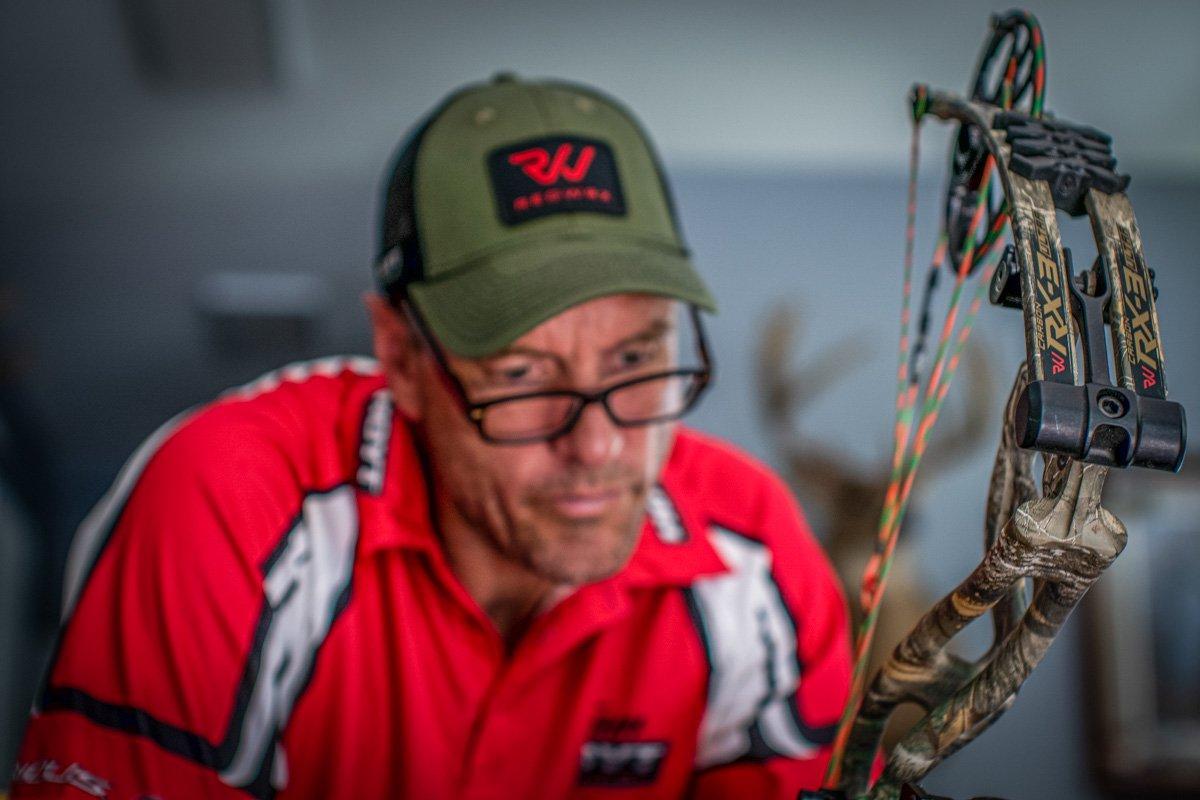The off-season advice you need to shoot tighter groups and make next bow season your best one yet
Deer season is in the rearview mirror with months to go until opening day. Every bowhunter should be proficient with their archery equipment. Likewise, they should strive for growth, and to become better than they were last season. With that in mind, we consulted with numerous archery professionals to compile the best off-season archery tips for bowhunters.
1. Reflect on Last Season
Pro: Donnie Thacker, Hoyt Pro Staffer
Preparation is the key to success. Thacker advises you should reflect on last season and think about problems and challenges that created issues with accuracy and form. Determine which things you can improve on before next fall.
Draw length, D-loop length, holding weight, stabilizer weight, cam timing and peep height are the places I focus on that seem to have the biggest effect on my performance, Thacker says. This is a great time to tweak those things and see if you get better or worse.
2. Set Specific, Actionable Goals
Before you ever begin, make sure your personal goals are clear, Betty says. Do you want your [bow] to tune perfectly? Do you want to improve your accuracy from 30 to 40 yards? Be clear about the objectives you're trying to address before ever using the first Allen wrench.
3. Exercise Now, Thank Us Later
Pro: Bill Winke, Midwest Whitetail
Winke is all about staying active and working on your overall body fitness.
I've participated in some endurance events, and those types of regimens appeal to me most, he says. If you breathe hard going up a treestand or walking up a hill, how can you expect to execute a tough shot under stressful conditions?
He likes to stack as many factors in his favor as possible. Winke encourages bowhunters to abide by an old philosophy. Control the things you can control, he says, so the impact from the things you cannot isn't as large.
4. Swap Your Equipment Now
Pro: Jeff Hopkins, Martin Archery
Hopkins believes it's best to make equipment changes as soon as possible.
Get the bow you plan to shoot, he says. Go over marks, test arrows with that bow and point weights of arrows, and test any other new equipment you plan to use in the upcoming season. This applies to everything from your release to your stabilizer. Complete your setup now so you can shoot it all summer.
5. Check Your String
Pro: Ted Fowler, Xpedition Archery
If you aren't the kind of bowhunter who regularly shells out for a new compound, just make sure to keep an eye on your bow string. When the string looks worn, frayed, stretched, or has damaged serving, it's time to replace it. String stretch also initiates creep, and naturally, the string gets slightly longer over time. It can impact draw length, peep position, anchoring and more.
After every deer season, I put on a new string, Fowler says. I shoot every day, and the string takes a beating throughout the year.
6. Tune with a Camera
Pro: Ted Fowler, Xpedition Archery
Tuning your bow is great, but recording the process is even better. It allows you to really break down your shot and troubleshoot any issues with your form.
Right now, I'm struggling and not shooting great, Fowler says. I changed to a helical vane, and I've noticed some side-to-side movement in the last couple days. I'm going to strip down a shaft and paper tune it to see what's off. I'm also going to set up a video camera so I can look at it in slow motion.
7. Draw and Hold
Pro: Larry McCoy, Elite Archery
Sometimes the best practice doesn't involve shooting at all. McCoy likes this drill, where he places a target inside 10 yards.
I'll nock an arrow, draw back, and put my pin on the dot, he says. I'll hold it there until I feel the shot start to break down. Then, I won't even fire the arrow. I'll just let down. Repeat that process several times per day, multiple times a week. It helps train muscle memory in correlation with aiming.
8. Blind-Bale Shooting
Pro: Jeff Hopkins, Martin Archery
This has long been a popular tactic to work out kinks, especially target panic. Aside from fixing target panic, it's still a great way to stay in good shape and practice your form. Hopkins often follows the blind-bale drill, which involves standing in front of a large target set up five yards away. Close your eyes, draw, and shoot - keeping your eyes shut throughout the shot. This allows you to remove variables like aiming (and the aforementioned target panic) from your shot, and focus instead on the quality of your form.
9. Shoot Better with Fewer Shots
Pro: Bill Winke, Midwest Whitetail
It's also important to focus on quality over quantity.
I rarely shoot more than 15 arrows in a practice session, but I try to make every shot as perfect as possible, Winke says. I also do 90% of my practice from long range - 60 yards or more - during the off-season. He says this makes normal 20- to 30-yard shots seem much easier when it comes time to hunt.
10. Try True Back-Tension
Pro: Bill Winke, Midwest Whitetail
Always create a surprise release with bow shots, Winke says. This is the way to beat target panic and shoot most consistently over a lifetime. I may spend a good part of my off-season using a back-tension release that doesn't have a trigger, so I get the feel of the surprise drilled very clearly into my central nervous system. Then, as I get closer to hunting time, I go back to my hunting release and continue to focus on the slow squeeze while letting the pin float around the spot I'm trying to hit. I've learned this method from very good archers and if you give it an honest effort, you will be surprised how well it works.
11. Mix Up Your Drills
Pro: Bill Winke, Midwest Whitetail
Use drills to keep your practice interesting, but choose ones that address the specific problems you're having and the goals you wish to accomplish.
I see people practice things that are not necessarily connected with the aspect they are trying to fix, Winke says. Because I hunt, my favorite is to stick arrows into the ground at various ranges, then run to each one of them and execute a perfect shot as quickly as I can. I do this to try and improve my eye-target-muscle coordination for quick, uncomfortable shot scenarios.
12. Stress Yourself Out
Pro: Kyle Barefield, All Things Hunting
Winke's drill (No. 11) also gets your heart rate up, which mimics the effects of adrenaline during a hunt. Barefield also likes to create high-stress situations to help him train for the real thing. There are numerous ways to do this.
Shoot with an audience watching whenever you can, Barefield says. The added stress can simulate shooting at a deer. Shoot at odd yardages to see where your arrow hits when you gap-shoot between the pins. If you can hunt hogs, go hunt hogs.
13. Compete When You Can
Pro: Bill Winke, Midwest Whitetail
For the ultimate challenge, introduce competition to your off-season activities.
You will never reach your potential as an archer unless you compete, Winke says. That kind of pressure makes you a better bowshot because it gives you a stronger reason to practice. Plus, you will automatically start to address your weaknesses and find ways to fix them.
14. Recognize Bad Days
Pro: Larry McCoy, Elite Archery
Understanding your normal routine and where your comfort level ends is also very important.
Some days, you're relaxed. You feel better, aim better and shoot flawlessly, McCoy says. But on days you're uncomfortable - maybe you drank too much coffee or are hungry - learn to really surpass those obstacles to ensure you're executing good shots.
15. Take Breaks
Pro: Donnie Thacker, Hoyt Pro Staffer
Thacker believes that we all need time away from the stick and string - both mentally and physically.
The way I've found to remain sharp is to hone those skills in other ways, Thacker says. Running and dieting seem to be great for me. It takes mental strength to push through pain. I've always despised running, so that helps give me confidence that I'm mentally tough and can push through adversity. Shooting guns is something fun that I do with the family, which helps me hone my breathing and trigger control while letting off a little steam.
Sometimes, avoiding a training rut and getting creative is the best thing you can do for your archery skills. Find the tips and drills that work for you, and you'll notice major improvements come bow season.
Don't Miss: Sweet Shooters: New Bows and Crossbows from ATA 2020
Check out more stories, videos and educational how-to's on deer hunting.












